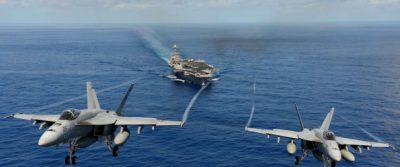Is Beijing Losing Its Footing in South China Sea?

The United States military launched nuclear-capable B-52H Stratofortress bombers over the heavily disputed South China Sea last week, where they “conducted routine training”. In these contested waters, the Chinese government has claimed ownership over reserves containing trillions of dollars worth of oil and gas.
The South China Sea is one of the most heavily trafficked maritime routes in the entire world. However, the conditions that make it so valuable–its location on the coasts of a considerable number of Asian countries–have also led to major regional tensions over ownership. Vast, overlapping swaths of this valuable body of water are currently being claimed by Brunei, China, Malaysia, Indonesia, the Philippines, Taiwan and Vietnam. China, which has staked the largest claims to the South China Sea and has been the most aggressive in its position with an ever-expanding military presence on the waters, has stirred up a large amount of political discontent in the region.
While China has been bolstering its military presence in and around the South China Sea, its positioning doesn’t come close to competing with the vast military presence of the United States in the Asia-Pacific region, where the Pentagon already holds an estimated and unrivalled 279 bases. The U.S. hasn’t been keeping idly by, either. This latest B-52 flyover is just one more military exercise of many, all of which are in open defiance of Chinese policy and warnings to the international community.
In a statement to the Hong Kong-based South China Morning Post, a spokesperson for the Pacific Air Force said that “two B-52H Stratofortress bombers took off from Andersen Air Force Base, Guam, and conducted routine training in the vicinity of the South China Sea on March 13, before returning to base.” In the same statement the spokesperson added that the launch was nothing out of the ordinary and that, “U.S. aircraft regularly operate in the South China Sea in support of allies, partners and a free and open Indo-Pacific.” Concurrently with the flyover of the B-52s on Wednesday, the Seventh Fleet flagship USS Blue Ridge amphibious command ship sailed directly through the South China Sea’s contested waters before anchoring in the Philippines.
This display of U.S. military might came just one day after Secretary of State Mike Pompeo decried Beijing for what he said was “illegal island-building in international waterways” with the purpose of cutting off rival claimants to the South China Sea “from accessing more than $2.5 trillion in recoverable energy reserves.” In response to these comments, Chinese Foreign Ministry spokesperson Lu Kang shot back on Wednesday that “it serves the interests of regional countries that those countries can manage and handle differences in their own way, and jointly uphold regional peace, stability, development and prosperity,” adding an additional jab that “Meanwhile, some non-regional country has repeatedly stirred up troubles in an attempt to ruin the harmony. Such attempts are irresponsible to regional countries.”
The military exercise came also just about a week after a separate pair of U.S. B-52s flew over South China Sea islands claimed by China as a part of the COPE North 2019 exercise. COPE is a “long-standing exercise…designed to enhance multilateral air operations among the U.S. Air Force, U.S. Navy, U.S. Marine Corps, Koku Jieitai (Japan Air Self-Defense Force) and Royal Australian air force (RAAF).”
When it comes to the South China Sea, the one thing that the U.S. and the Chinese definitely agree upon is its massive geopolitical value. According to a February 2013 report by the U.S. Environmental Information Agency, “the South China Sea contains approximately 11 billion barrels of oil and 190 trillion cubic feet of natural gas in proved and probable reserves.” Meanwhile, according to the same 2013 report, the official Chinese National Offshore Oil Company “estimated the area holds around 125 billion barrels of oil and 500 trillion cubic feet of natural gas in undiscovered resources.” With these numbers, it’s safe to say that the South China Sea won’t be fading from the headlines any time soon.
*
Note to readers: please click the share buttons below. Forward this article to your email lists. Crosspost on your blog site, internet forums. etc.
Haley Zaremba is a writer and journalist based in Mexico City. She has extensive experience writing and editing environmental features, travel pieces, local news in the Bay Area, and music/culture reviews.
Featured image is from OilPrice.com

